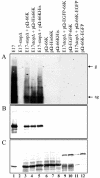Targeting of the turnip yellow mosaic virus 66K replication protein to the chloroplast envelope is mediated by the 140K protein
- PMID: 12915529
- PMCID: PMC187420
- DOI: 10.1128/jvi.77.17.9124-9135.2003
Targeting of the turnip yellow mosaic virus 66K replication protein to the chloroplast envelope is mediated by the 140K protein
Abstract
Turnip yellow mosaic virus (TYMV), a positive-strand RNA virus in the alphavirus-like superfamily, encodes two replication proteins, 140K and 66K, both being required for its RNA genome replication. The 140K protein contains domains indicative of methyltransferase, proteinase, and NTPase/helicase, and the 66K protein encompasses the RNA-dependent RNA polymerase domain. During viral infection, the 66K protein localizes to virus-induced chloroplastic membrane vesicles, which are closely associated with TYMV RNA replication. To investigate the determinants of its subcellular localization, the 66K protein was expressed in plant protoplasts from separate plasmids. Green fluorescent protein (GFP) fusion and immunofluorescence experiments demonstrated that the 66K protein displayed a cytoplasmic distribution when expressed individually but that it was relocated to the chloroplast periphery under conditions in which viral replication occurred. The 66K protein produced from an expression vector was functional in viral replication since it could transcomplement a defective replication template. Targeting of the 66K protein to the chloroplast envelope in the course of the viral infection appeared to be solely dependent on the expression of the 140K protein. Analysis of the subcellular localization of the 140K protein fused to GFP demonstrated that it is targeted to the chloroplast envelope in the absence of other viral factors and that it induces the clumping of the chloroplasts, one of the typical cytological effects of TYMV infection. These results suggests that the 140K protein is a key organizer of the assembly of the TYMV replication complexes and a major determinant for their chloroplastic localization and retention.
Figures






Similar articles
-
Assembly of turnip yellow mosaic virus replication complexes: interaction between the proteinase and polymerase domains of the replication proteins.J Virol. 2004 Aug;78(15):7945-57. doi: 10.1128/JVI.78.15.7945-7957.2004. J Virol. 2004. PMID: 15254167 Free PMC article.
-
Detection and subcellular localization of the turnip yellow mosaic virus 66K replication protein in infected cells.Virology. 2001 Mar 1;281(1):88-101. doi: 10.1006/viro.2000.0769. Virology. 2001. PMID: 11222099
-
Identification and Molecular Characterization of the Chloroplast Targeting Domain of Turnip yellow mosaic virus Replication Proteins.Front Plant Sci. 2017 Dec 19;8:2138. doi: 10.3389/fpls.2017.02138. eCollection 2017. Front Plant Sci. 2017. PMID: 29312393 Free PMC article.
-
The ubiquitin-proteasome system regulates the accumulation of Turnip yellow mosaic virus RNA-dependent RNA polymerase during viral infection.Plant Cell. 2010 Sep;22(9):3142-52. doi: 10.1105/tpc.109.072090. Epub 2010 Sep 7. Plant Cell. 2010. PMID: 20823192 Free PMC article.
-
Proteolytic processing of turnip yellow mosaic virus replication proteins and functional impact on infectivity.J Virol. 2007 Oct;81(20):11402-12. doi: 10.1128/JVI.01428-07. Epub 2007 Aug 8. J Virol. 2007. PMID: 17686855 Free PMC article.
Cited by
-
Investigating the role of viral integral membrane proteins in promoting the assembly of nepovirus and comovirus replication factories.Front Plant Sci. 2013 Jan 29;3:313. doi: 10.3389/fpls.2012.00313. eCollection 2012. Front Plant Sci. 2013. PMID: 23439982 Free PMC article.
-
The SNARE protein Syp71 is essential for turnip mosaic virus infection by mediating fusion of virus-induced vesicles with chloroplasts.PLoS Pathog. 2013;9(5):e1003378. doi: 10.1371/journal.ppat.1003378. Epub 2013 May 16. PLoS Pathog. 2013. PMID: 23696741 Free PMC article.
-
RH3 enhances antiviral defense by facilitating small RNA loading into Argonaute 2 at endoplasmic reticulum-chloroplast membrane contact sites.Nat Commun. 2025 Feb 25;16(1):1953. doi: 10.1038/s41467-025-57296-6. Nat Commun. 2025. PMID: 40000658 Free PMC article.
-
The Forgotten Tobamovirus Genes Encoding the 54 kDa Protein and the 4-6 kDa Proteins.Viruses. 2024 Oct 28;16(11):1680. doi: 10.3390/v16111680. Viruses. 2024. PMID: 39599795 Free PMC article. Review.
-
The potato mop-top virus TGB2 protein and viral RNA associate with chloroplasts and viral infection induces inclusions in the plastids.Front Plant Sci. 2012 Dec 24;3:290. doi: 10.3389/fpls.2012.00290. eCollection 2012. Front Plant Sci. 2012. PMID: 23269927 Free PMC article.
References
-
- Ausubel, F. M., R. Brent, R. E. Kingston, D. D. Moore, J. G. Seidman, J. A. Smith, and K. Struhl. 1987. Current protocols in molecular biology. Wiley, New York, N.Y.
-
- Barends, S., H. H. Bink, S. H. van den Worm, C. W. Pleij, and B. Kraal. 2003. Entrapping ribosomes for viral translation: tRNA mimicry as a molecular Trojan horse. Cell 112:123-129. - PubMed
-
- Bass, B. L. 2000. Double-stranded RNA as a template for gene silencing. Cell 101:235-238. - PubMed
-
- Bransom, K. L., S. E. Wallace, and T. W. Dreher. 1996. Identification of the cleavage site recognized by the turnip yellow mosaic virus protease. Virology 217:404-406. - PubMed
Publication types
MeSH terms
Substances
LinkOut - more resources
Full Text Sources

